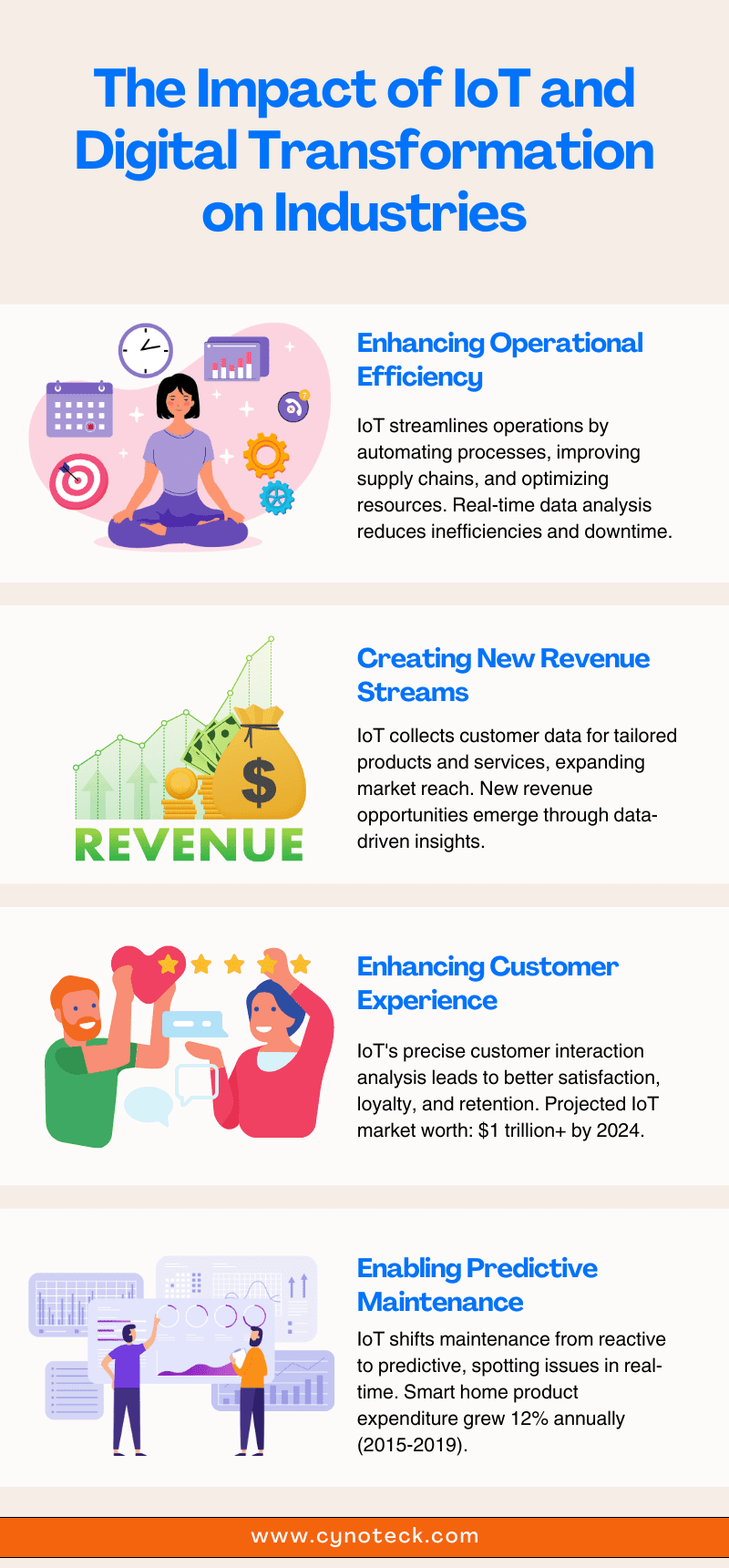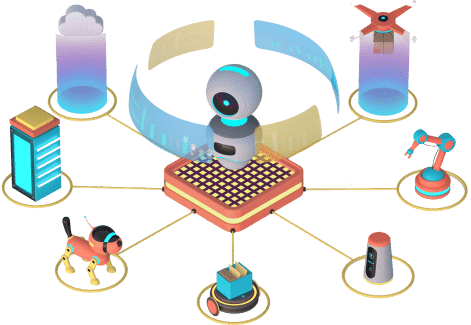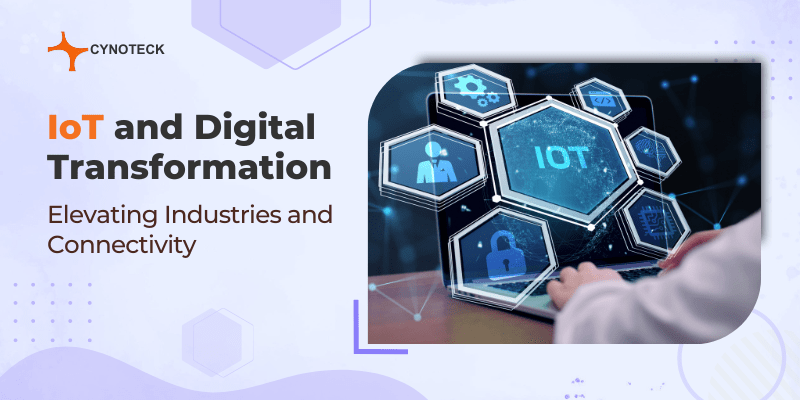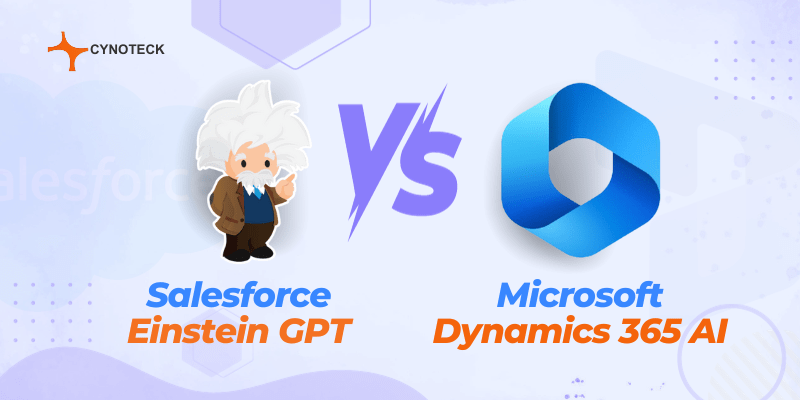In today’s fast-paced and interconnected world, the convergence of IoT and Digital Transformation has sparked a technological revolution that is reshaping industries and enhancing connectivity like never before. The Internet of Things (IoT) has emerged as a notable change, connecting billions of devices and sensors to the Internet, facilitating seamless data exchange, and empowering industries to operate smarter and more efficiently.
Meanwhile, Digital Transformation has become a critical strategy for businesses seeking to thrive in the digital age, leveraging innovative technologies to revolutionize their operations, enhance customer experiences, and stay competitive in the dynamic market landscape.
This blog explores the powerful constructive collaboration between IoT and Digital Transformation and its profound impact on various industries. From healthcare to manufacturing, transportation to retail, we will delve into how IoT-driven innovations are optimizing processes, enabling predictive insights, and fostering unprecedented levels of connectivity.
We will uncover the role of enhanced connectivity in this transformative journey and examine the challenges and opportunities that arise with the adoption of IoT and Digital Transformation. Through compelling case studies and future trends, we will highlight how embracing these technologies is not only revolutionizing industries but also enhancing our daily lives in remarkable ways.
IoT and Digital Transformation
A digital transformation firm involves more than simply the platform or the technologies. It concerns a fresh method of doing business. IoT is transforming how businesses approach their operations and how their partners and clients engage with them, opening new possibilities for revenue development and client engagement.
According to a report by IDC, global spending on goods and services that support digital transformation is expected to reach up to $2.3 trillion by 2023.
Businesses have a ton of options to modernize their operations and procedures with the help of the Internet of Things (IoT), which will result in better and more efficient services.
Businesses can access real-time data, automate procedures, and get more insight into their operations by integrating physical systems and devices with one another and the cloud.
Businesses can benefit from this by saving time, money, and resources, as well as by enhancing the customer experience and lowering operating expenses.
IoT can also support new business models, enabling companies to generate fresh goods and services as well as new sources of income. IoT is a crucial component of any strategy for digital transformation.
Also, read: Salesforce IoT Cloud: Challenges & Benefits for Business Operations
Importance of enhanced connectivity in today’s interconnected world
Information and technology keep advancing, and as a business, you must stay updated. There is no exaggeration in hunting down the latest trends and acing its practice in your business. It is a must-have.
Market leaders face competition from quick and agile companies that use cutting-edge technology. Also, firms should embrace the greatest digital transformation strategies to stay current or advance in the competition.
As exposure to customer experience has been the top priority, it is crucial to implement digital transformation. Not only does it help to benefit businesses internally but also creates a great UX.
To grow, adopting best practices is now non-negotiable.
Also, read: IoT in Healthcare in 2023: Companies, Medical Devices, and Use Cases
Benefits of incorporating IoT into digital transformation:

Automation
IoT gadgets can be utilized to automate labor-intensive, tiresome tasks. Processes can be made more efficient, effective, and error-free by automation, which eventually speeds up the innovation process.
This enables businesses to gather and analyze data in real-time to acquire insightful information and make data-driven decisions. It may also be used to expedite data collecting. In addition to quickening the development process, this also lowers the price of data collection and analysis.
Connectivity
IoT devices can be used to link different systems and enable the sharing of data and information. This can be applied to encourage collaboration and data exchange, which will hasten the digital transformation process.
Businesses can create a variety of goods and services that can result in a completely new level of efficiency, cost savings, and customer happiness by utilizing the power of connection. This can be accomplished by combining data sources and developing improved methods for managing and monitoring linked devices.
By 2025, the healthcare AI sector will present a total revenue opportunity of more than $34 billion, as predicted by BusinessWire.
Monitoring and analytics
IoT devices can be used to monitor and analyze data in real-time, offering insightful information that can be utilized to make better decisions. Businesses can use this to analyze trends, spot potential problems before they happen, and cut down on downtime.
Additionally, it offers a means of better-comprehending consumer behavior and gaining insightful knowledge of their preferences. With this information, companies may better design their goods and services to satisfy customer wants, which will increase client loyalty and profitability.
Security
IoT solutions can provide extra levels of protection to shield systems and data from potential dangers. By doing so, the possibility of data breaches and other dangerous acts may be decreased.
Automation of security-related activities and procedures is another benefit of IoT solutions.
Reducing the time and effort needed to maintain a safe environment can free up time for organizations to concentrate on other aspects of their business.
Additionally, organizations can be certain that their security measures are consistently current and efficient in protecting their data and systems by implementing automated security.
Also, read: Unlocking the Power of AI in Digital Transformation: A Roadmap to Success
How do IoT and Digital Transformation work together?
IoT platform technologies enable traditional businesses to transition to become digital-based businesses. Being digitally transformed helps businesses to be more competitive. It welcomes innovation and enhances productivity. And the core of every transformation is to deliver better outcomes and enriched customer experience.
The sole reason businesses grow upscale is to provide a wholesome experience to users. Being more present for consumers helps to connect with them. If consumers are aware of your growth, they will choose you. To simplify, digital presence adds many advantages to your business.
IoT is more like a portal to a new world of possibilities for businesses. As soon as firms leave behind the traditional methods and start their digital journey, there are different ways to scale business.
Entering a new platform brings along the competition. Be it young start-ups or mid to large-scale businesses, everyone is in the same league.
It is essential to plan, execute and implement the right techniques to grow and expand business digitally.
Also, read: The Importance of Web Development in Digital Transformation
The Impact of IoT and Digital Transformation on Industries

Enhancing Operational Efficiency
IoT connectivity is streamlining operations by automating manual processes, improving supply chain management, and optimizing resource utilization. There are numerous ways to conduct analysis and curate metrics.
IoT helps to track, share, and evaluate data whenever businesses want to communicate with consumers. These real-time data enable organizations to identify inefficiencies, reduce downtime, and increase productivity.
According to a report by IDC, worldwide spending on the Internet of Things (IoT) is expected to reach $1.1 trillion in 2023.
Creating New Revenue Streams
IoT is an era of endless possibilities. How? As the digital platform expands for businesses to increase reach it also welcomes revenue. With IoT devices, businesses can collect data on customer behavior, preferences, and usage patterns.
When businesses collate user-specific information, then it helps for new products and services. Now when data is extracted based on customer needs, it promises expansion.
Not only does it help to serve consumers better but also expands into reaching out to new consumer premises.
Enhancing Customer Experience
Fulfilling customer needs assists in the business’s growth exponentially. Personalization helps in more revenue. IoT contributes to getting better analysis of customer interaction.
If a business can cater to business requirements and satisfy customer needs, then it generates customer loyalty.
Businesses are steady when customer retention is much higher. And consumers prefer to always choose the same product and service when businesses are providing what users need.
According to GlobalData, the global internet of things (IoT) market by revenue will be worth $1.1 trillion by 2024.
Enabling Predictive Maintenance
IoT connectivity enables businesses to shift from reactive maintenance to predictive maintenance.
With IoT devices, businesses can collect data on equipment performance, analyze it in real-time, and identify potential issues before they become critical.
A predictive approach not only helps to avoid any downtime but also promises longevity.
According to Statista, consumer spending on smart home products and services is forecast to grow to more than 170 billion U.S. dollars by 2025.
Also, Read: Digital Transformation in Healthcare: Key trends in healthcare for 2023
Challenges and Considerations of IoT & Digital Transformation
Digital transformation is still frequently seen as a cost center, according to 28% of businesses, and 29% of them say it is difficult to get evidence to demonstrate ROI.
These include legal and compliance complexities, deep-rooted perspectives, a 26% resistance to change, and a similar percentage expressing concerns about compliance.
Navigating these issues requires a strategic approach and a concerted effort to overcome barriers in implementing data-driven practices successfully.
Data security and privacy
IoT generates data, and that cultivates risks. Data theft is prone to attacks & theft. While switching to digital platforms, businesses should first plan all the possible ways to protect data.
Either by encryption, safety measures, privacy policies, etc. Go through all the data regulations and norms to protect the data.
It is mandatory to inform users prior to their information being shared on the platform. Proper user authentication practices must be adopted to be secure. Also, customers should be reminded sometimes about the possible risk.
On the other hand, all the security and privacy concerns must be timely checked. IoT is an endless possibility but that is inclusive of several risks too.
Integration and interoperability
IoT users use diverse types of devices. And each system is from a different platform. Now that arises issues. What types of potential challenges? Well, due to multiple or various vendors or protocols, the functionality & reliability of the network are affected.
To ensure integration and interoperability, you need to choose IoT devices and systems that follow common standards and protocols or use middleware or gateways that can translate and bridge different formats and languages.
Promising results can be attained via regular testing and monitoring. If your IoT network is outdated or requires an update, make sure to follow that timely. In short, compatibility is more than necessary. Make sure to follow all the essential steps.
Scalability and reliability
A common challenge for IoT can be scalability. There can be several types of devices and they can change or grow at an overly aggressive rate. Now maintaining this can be a change. It gets difficult to keep or monitor these devices.
This can also put pressure on the network bandwidth, storage, and processing capabilities, which can affect the speed, quality, and availability of IoT services.
It is important to use cloud computing, edge computing, or fog computing solutions that can offer flexible, dispersed, and resilient resources when designing and deploying an IoT network.
Additionally, you must employ techniques and tools for automating, enhancing, and troubleshooting your IoT network and devices.
Legal and regulatory compliance
Because they can operate in a variety of authorities, markets, and fields, IoT devices and systems may be subject to a range of legal and regulatory obligations.
These can include laws and rules pertaining to data protection, consumer protection, product liability, intellectual property, the environment, human health, and safety.
You must conduct research on and comprehend the legal and regulatory frameworks that apply to your IoT devices and systems, as well as the markets and clients you service, to ensure legal and regulatory compliance.
Additionally, you must put rules and procedures into place that can guarantee accountability and compliance as well as deal with any potential controversies or infractions.
IoT systems and gadgets have the potential to have a significant impact on society, the environment, the economy, and culture, which can lead to ethical and societal problems.
The hazards of bias and discrimination, the repercussions of automation and artificial intelligence, the ramifications of security breaches or failures, and the obligations of the parties involved are just a few examples of these.
You must adopt a human-centric and value-based approach to your IoT design and development, as well as your IoT strategy and governance, to ensure ethical and social responsibility.
To comprehend their wants, expectations, and feedback, you should also interact and consult with your users, customers, workers, partners, regulators, and other pertinent parties.
Also, read: Vertical Experience in Digital Transformation: 5 Questions to Ask Your Contractor
Conclusion
As expressed, the idea of the Internet of Things has a considerable influence on digital transformation. IoT solutions can improve customers’ shopping experiences while enabling businesses to stay in constant contact with clients and staff. IoT will undoubtedly support digital transformation in the future, as is expected.
In conclusion, the combination of IoT and Digital Transformation has ushered in a new era of innovation and efficiency across various industries, fundamentally reshaping the way businesses operate and individuals interact with technology. From healthcare to manufacturing, transportation to retail, these transformative technologies have enabled seamless connectivity, empowered data-driven decision-making, and improved overall productivity.
However, as we embrace the potential of this interconnected landscape, it is vital to address security concerns, data management challenges, and the need for continuous upskilling. By harnessing the power of IoT and embracing Digital Transformation, industries can unlock their full potential, driving sustainable growth, and creating a more connected and advanced world for us all.
Also, read: Digital Pharma: How Mobile Technology is Changing Healthcare?
Frequently Asked Questions:
IoT enables industries to connect and monitor devices, collect valuable data, and optimize processes, leading to increased efficiency, reduced costs, and improved customer experiences.
Digital Transformation involves adopting advanced technologies and integrating them into all aspects of a business to drive innovation, streamline operations, and stay competitive in the rapidly changing market.
IoT devices like smart home appliances, wearables, and connected cars enable seamless communication, allowing us to control and access data remotely, making our lives more convenient and efficient.
Some challenges include ensuring data security and privacy, managing vast amounts of data, integrating legacy systems, and the need for upskilling the workforce to adapt to technological changes.
Smart city initiatives like Barcelona’s IoT-based waste management system, Amazon’s implementation of robots in their fulfillment centers, and the use of IoT sensors in precision agriculture are all examples of successful IoT and Digital Transformation applications revolutionizing industries.

AI Consulting Services
Planning to Leverage AI for your business? We provide AI Consulting to help organization implement this technology. Connect with our team to learn more.




